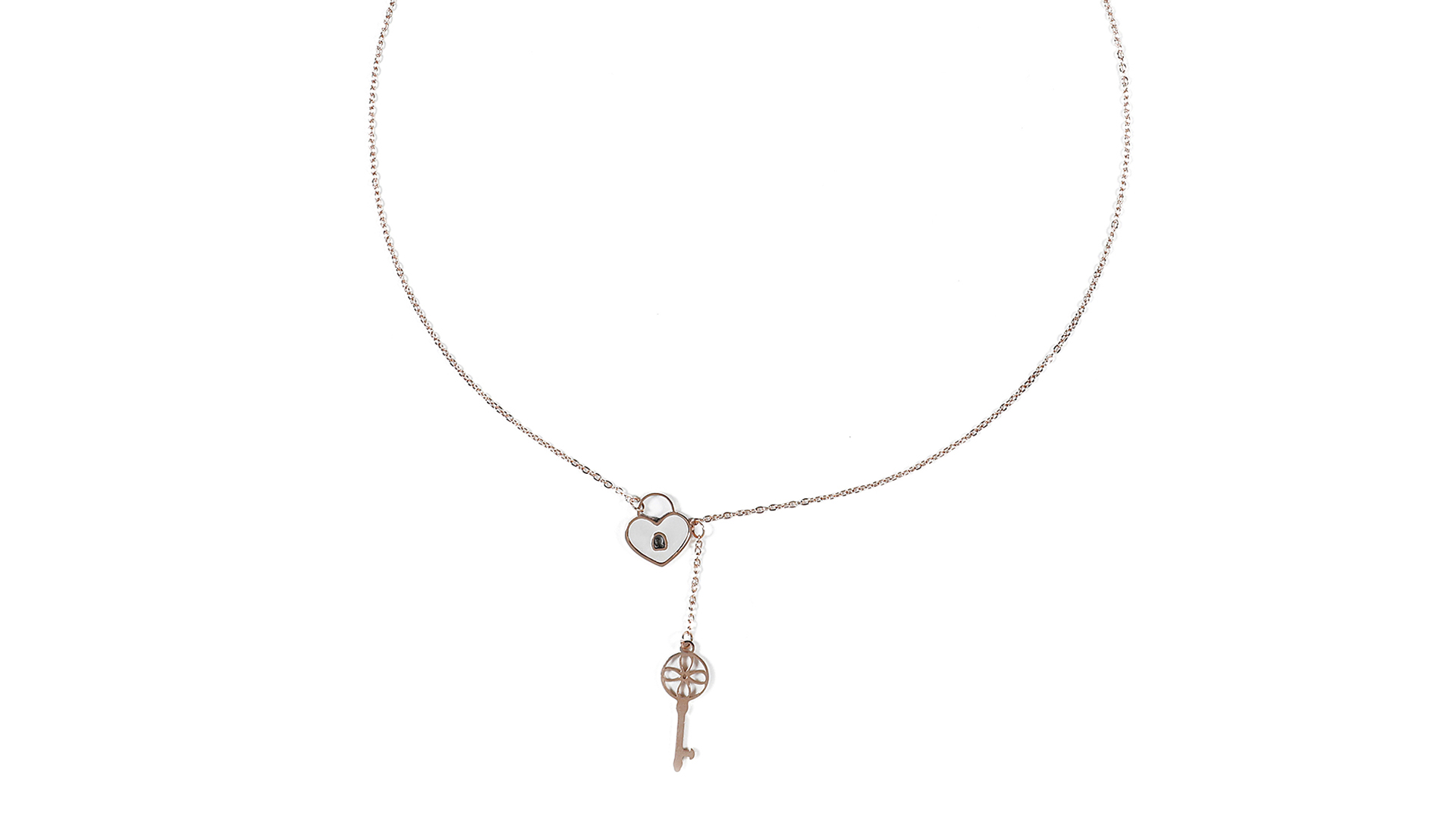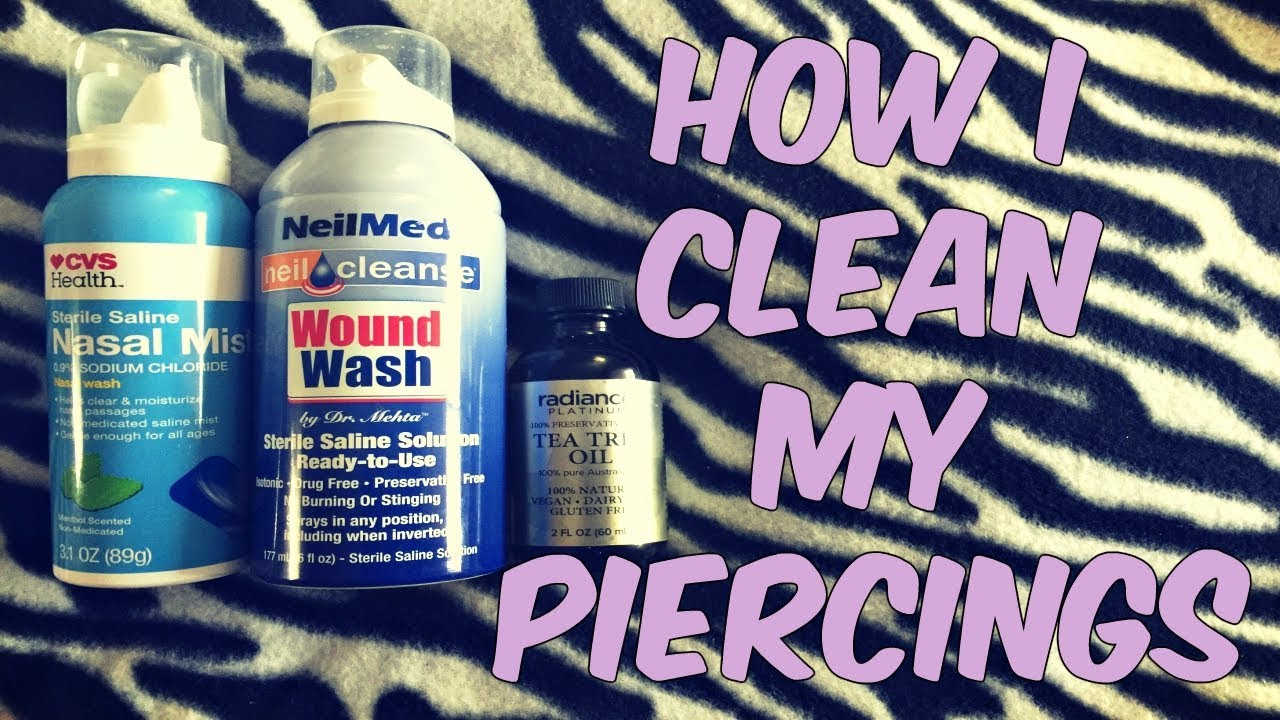The jewelry world is full of confusing terminology that can make a simple buying decision feel overwhelming. But don’t worry! Here to break down two commonly confused designations and the pros and cons of each. Churinga will tell you the main differences between gold plated jewelry and gold filled jewelry.
GOLD PLATED JEWELRY
What is Gold Plated Jewelry ?
Gold plating on jewelry allows you to have an item with the beautiful look of gold without having the entire item made of solid gold. With gold being so precious, having a piece of jewelry made of solid gold is not an option for many people. The amazing thing about gold plating is you can impart all the qualities of gold into a piece withoust the huge cost. As a accessable jewelry it having following advantages.
1.Tarnish Resistance:
Gold does not tarnish, rust, corrode and is hypoallergenic. Due to these great qualities, many people choose to coat items that otherwise may become problematic if exposed to conditions that may damage the item or cause an allergic reaction. In the case of costume jewelry or jewelry that is made of brass, bronze, silver, copper, nickel etc., gold plating will keep the piece from turning your finger green and most importantly keeps the piece from quickly degrading from corrosion. Brass, for instance, will quickly corrode when it comes in contact with our sweat. Our sweat contains salt, (sodium chloride), which can quickly tarnish brass within days after touching it. If it is gold plated correctly, this issue is completely eliminated.
2.Increasing Value:
Most jewelry makers and artists choose to make their pieces out of brass, bronze, silver or copper as it is affordable and easy to work with. As we have covered in the “Tarnish Resistance” section above, this is a problem especially when attempting to make a classy, long-lasting piece. Selling a piece made of one of these metals at a high price is quite difficult because of the issues we mentioned regarding tarnishing. Once gold is applied, even if it is a relatively thin layer of gold plating, the entire value of the piece greatly increases. An example; we have a customer who buys Italian silver necklaces for $20 per piece, they then gold plate these pieces with 24 Karat gold and resell them for $200 per necklace. You may wonder, well how much gold was actually applied? The answer is, only a few dollars worth. An one liter bottle of our 24K Bright Gold Solution contains 2.5g fine-gold. One gram of fine-gold will plate approximately 160 square inches of area to a thickness of 1/2 micron, (0.00002″ or 20 micro-inches). This means you can plate around 160 rings or pendants that have about one square inch of area for $110. In other words, it works out to be about $0.68 to gold plate a ring or pendant this size.
3.Diversifying Your Selections:
Having the ability to electroplate items is special. Not many have the know how or capability to do so. With kits, solution and support like we offer, it opens the door to a whole new world of possibilities. Lets say you make pendents or rings out of silver – if you have a kit like the JewelMaster Pro HD, you could offer your same ring in multiple different finishes. You could offer 24k, 18k, 14k, Rose Gold, Rhodium, Black Rhodium, Silver etc. Everyone has different preferences about the color they want within a certain style. Having this ability is priceless for many jewelers and artists alike.
4.Longevity:
Many people want to know, “How long will it last?” There are three main factors that affect how long gold plating will last.
5.Types of Gold:
Gold is a soft metal by nature. However, there are “hardened” gold deposits and “soft” gold deposits. Hardened gold is hardened by adding grain modifiers and hardening agents such as cobalt. The grain modifiers in a hardened gold will disrupt the lattice formation of the gold crystals as they form on the surface. This disruption allows for the crystals to be much more tightly packed and therefore makes for a “harder” deposit. The “Knoop hardness” of a hardened gold is 3-5 times harder than that of a “soft” gold. When plating jewelry, hardened gold should always be used. Soft “Pure” Gold is typically used in scientific plating applications, such as fuel cells, where the gold needs to be applied relatively thick and needs to be softer, resist higher temperatures, or cannot have any contaminants. Soft (Pure) Gold has a 99.99%+ minimum purity whereas hardened gold has 99.97%+ minimum purity – that .02% can be very important in some applications.
6.Thickness:
Gold becomes opaque within seconds of plating, right around a thickness of 2-3 micro-inches. If you were to stop plating as soon as the item plating becomes opaque, you will be left with an extremely thin layer of gold that will wear off quickly – probably within a week or so. However, if you leave a piece in our 24K Bright Gold for 5.5 minutes you will have a layer that is ~40 micro-inches thick. 40 micro-inches (1 micron) is a relatively thick layer of gold plating and will last many years if not a lifetime if taken care of correctly. Our 24K Bright Gold is capable of plating up to 100 micro-inches (2.5 microns) in one contiguous layer. These types of thickness will last a lifetime if not abrasively removed.
7.Wear and Tear:
Due to the soft nature of gold it is susceptible to scratching and abrasion. For this reason we suggest you never polish gold with an abrasive polish. If an item is being handled heavily, such as a ring that is being slid on and off of a finger, sometimes daily, it is advised that the plating should be applied on the higher end of the thickness scale. Whenever we receive jewelry items to be plated we always apply at least 40 micro-inches (1 micron) to ensure a long-lasting plate for the customer. 20 micro-inches is the minimum thickness of gold plating for jewelry items to be sold as “gold plated” in the United States under the US Federal Trade Commission standards. Unfortunately many items from China and other unregulated countries may have layers as thin as 3-5 micro-inches.
A base metal like brass or copper is used to make gold plated jewelry. Once the base metal is rinsed, cleaned, and shaped, a nickel layer is attached to work as a “buffer” between the gold plating and the metal base. In the last phase, electroplating is used to deliver the nickel-plated base into a gold plating tank.
The plating, however, doesn’t compose any quantifiable proportion of the jewelry’s total weight. In fact, the total amount of gold a plated item usually has is under 0.05% of the overall weight of the product. In terms of durability, gold plating generally wears off quickly and can’t stand up to wear, water, or heat over time.
How long does gold plated jewelry last?
Gold plating wears out over time and can flake off, exposing the base metal underneath. It also loses its luster and fades with time. In general, plating can last for up to two years with proper care.
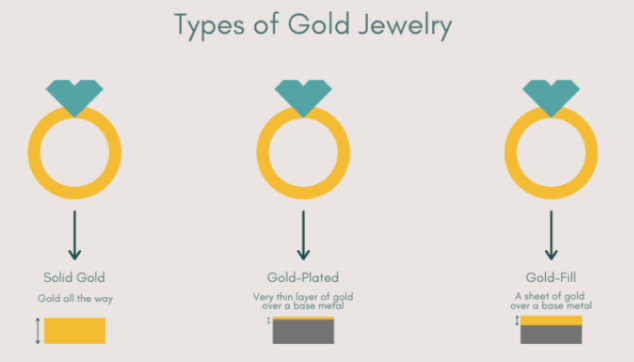
GOLD FILLED JEWELRY
What is Gold Filled Jewelry ?
Gold filled jewelry contains an actual layer of gold that’s “pressure bonded” to a core metal using pressure and heat. Unlike electroplated (dipped or plated) metals, gold filled pieces legally need to feature 1/20 or 5% of gold by weight. In terms of karat, the gold layer on the jewelry is 10k or higher.
Gold filled pieces are much thicker than gold plated ones, but still can’t beat solid gold. The base metal for this type of jewelry can be silver, copper or brass. Because gold filling is much more intense and consumes gold in a higher quantity, the price tag of gold filled jewelry is often higher than that of gold plated pieces.
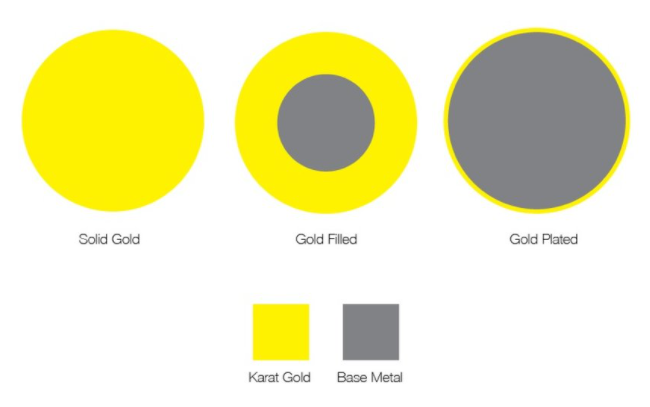
GOLD PLATED JEWELRY vs GOLD FILLED JEWELRY
What is the difference between gold plated jewelry and gold filled jewelry?
Different manufacturing processes
The amount of gold alloy used on gold-filled pieces is different than gold-plated.
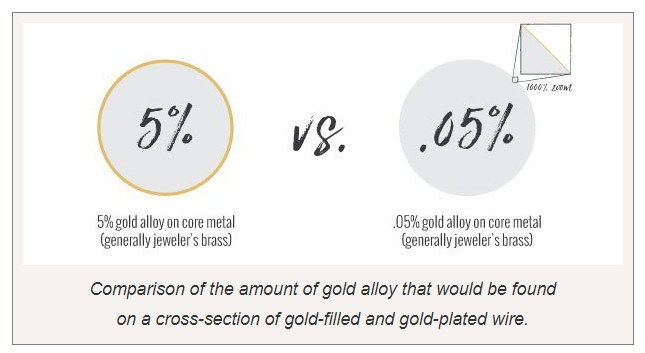
The layer of gold alloy on gold-plated jewelry is so minuscule it is barely noticeable in the above image. Gold-filled jewelry has 100x more gold alloy than gold plated and because that layer is so much thicker, it means gold-filled jewelry lasts longer and stands up to wear and tear better than gold plated. All it would take is one small scratch on a gold-plated piece to expose the jeweler’s brass underneath.
To make gold-filled pieces, the core metal is sandwiched between two layers of gold alloy which is then heated and passed through a roller several times – a process that both bonds the metals together and thins the sheet out.
To make gold-plated pieces, an electric current is used to negatively charge the base metal and positively charge a solution containing gold ions. The positive gold ions are attracted to the negative charge of the core metal, slowly forming a layer of gold on top of the core.
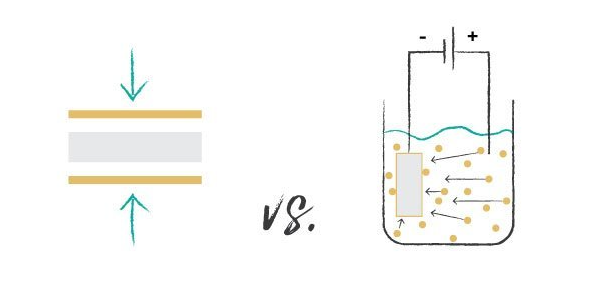
Thicker amounts of gold alloy can be added during both processes but typically the amounts shown before are the standard.
How to make a purchase decision ?
1. Budget
When it comes time to make a buying decision, make sure your bank or PayPal account has enough balance to back up your purchase. Gold filled pieces tend to be on the higher end of the cost spectrum while gold plated jewelry is more affordable as it only has a thin layer of gold to deliver the “appearance of gold.” That’s the reason why most fashion jewelry pieces are gold plated—they can be priced lower and appeal to a broader customer base.
Consider buying gold filled jewelry when selecting a meaningful (yet relatively affordable) gift or a piece of jewelry intended for everyday use! Consider buying gold plated jewelry when selecting trendy fashion pieces or costume jewelry!
2. Tarnishing
Because of the thin layer of gold that wears off after a while, gold plated jewelry will begin to tarnish once the base metal is exposed. Gold filled jewelry, on the other hand, will only tarnish under unique circumstances. Pure gold pieces barely tarnish, and even though they’re an alloy, the heavy layer on gold filled jewelry protects against tarnishing. We recommend that wearers clean gold filled pieces with mild soapy water or untreated cloth. For gold plated jewelry, clean only if it’s an absolute necessity. Use a cotton ball for the purpose, and avoid scrubbing your gold items.
3. Skin sensitivity
It’s also important to have an idea about the sensitivity of your skin before you invest in a gold filled or gold plated piece. Are you allergic to metals like copper, rhodium, silver or brass? If that’s the case, you might want to buy a gold filled jewelry piece as you won’t need to worry about any allergic response. We say this because gold plating may comprise cheaper raw materials that can trigger an allergic reaction in your skin, causing oxidation and irritation down the road. You won’t have this problem with gold filled alternatives
4. Durability
As we stated earlier, gold filled jewelry is more resistant to wear and tear than gold plated items due to the thicker layer of the alloy. However, the overall longevity of both is dependent on the environment, quality of the jewelry, and exposure to wear. As long as gold filled pieces are well cared for, they can last a lifetime. Gold plated pieces, on the other hand, can last up to a year if kept away from water, wear, and heat. It’s also worth mentioning that gold filled pieces with lower karat weight (9-14k) may be more durable than pieces with greater gold content.
How long does gold filled jewelry last?
Most high quality gold-filled pieces have the same appearance as high carat gold, and gold-filled items, even with daily wear, can last 10 to 30 years though the layer of gold will eventually wear off exposing the metal underneath.How to clean gold jewelry?
- Add a few drops of the mild washing-up liquid to one of the bowls of lukewarm water.
- Soak your jewellery in the bowl with washing-up liquid for ten minutes.
- Clean gently with the soft-bristled brush.
- Rinse well in the clean water.
- Dry and polish with the lint-free cloth.
How to clean gold plated jewelry?
- Dilute two drops of mild dish soap in warm water.
- Dip your gold jewelry into the mixture.
- Remove your piece from the soapy water and rinse it under clean warm water.
- Gently rub the item with a polishing cloth to restore its shine.
How to clean gold filled jewelry?
There is serveral methods you can choose fromMild soapy water and a toothbrush
Mild soapy water and a toothbrush – a child’s soft toothbrush and a mild detergent is the perfect combination for cleaning golf-filled jewelry. The detergent can remove residue or fingerprints from the item, and still leave it shiny and bright when it’s done. Be sure the toothbrush is soft or it may scratch your piece!Brilliant Soft Cloth
Soft cloth – using a clean, soft cotton cloth is an ideal way to polish your gold-filled pieces. A soft cloth will not scratch the surface. There are treated jewelry polishing cloths, such as Brilliant, that work well; however, some chemicals are not recommended on gold-filled items so double check that they are safe to use. Do not leave chemicals on your gold-filled. Always rinse and polish again with a soft cloth to remove residue.Ultrasonic Machine
Ultrasonic machine – quickly clean your pieces with an ultrasonic machine. Be sure you don’t leave the pieces in for too long (check every 2-3 minutes) but most importantly make sure that the cleaning solution is safe to use with gold-filled items! Rinse with water and dry with a soft cloth when you are finished.How to restore gold plated jewelry?
How to make gold plated jewelry gold again- Dilute two drops of mild dish soap in warm water.
- Dip your gold jewelry into the mixture.
- Remove your piece from the soapy water and rinse it under clean warm water.
- Gently rub the item with a polishing cloth to restore its shine.
How to tell if jewelry is real gold?
Scratch lightly on the jewelry’s surface and apply a small amount of nitric acid on it using a dropper. If the surface turns green, your jewelry might be gold clad. A milky substance appears if your gold contains sterling. Cosmetics may also help you determine if your gold is real or fake.
Ten articles before and after
What are the types of jewelry surface finishes and techniques ?
How to choose ODM and OEM ? Churinga will tell you
Zircon vs Cubic Zirconia : what is the difference between zircon and cubic zirconia ?
WHY SHOULD WE CHOOSE 316L STAINLESS STEEL JEWELRY?
WHY MORE MEN ARE WEARING JEWELRY?
Pink Gold vs. Red Gold vs. Rose Gold : What is rose gold really made of ?
What are the differences between brass and bronze?
Who’s the Best, Fashion Jewelry, Semi-Fine Jewelry and Fine Jewelry
